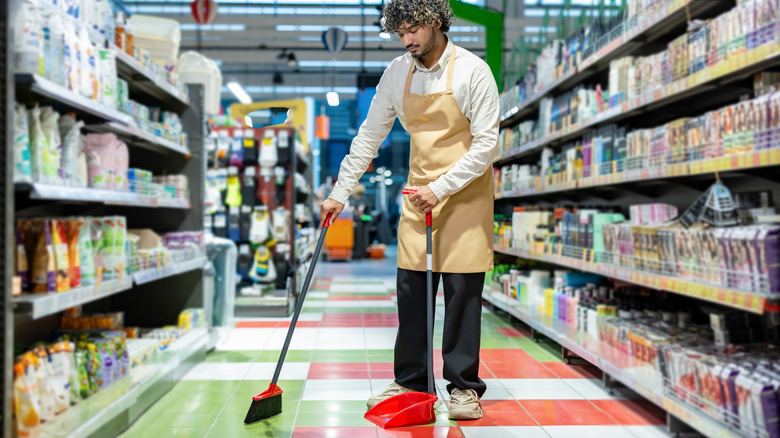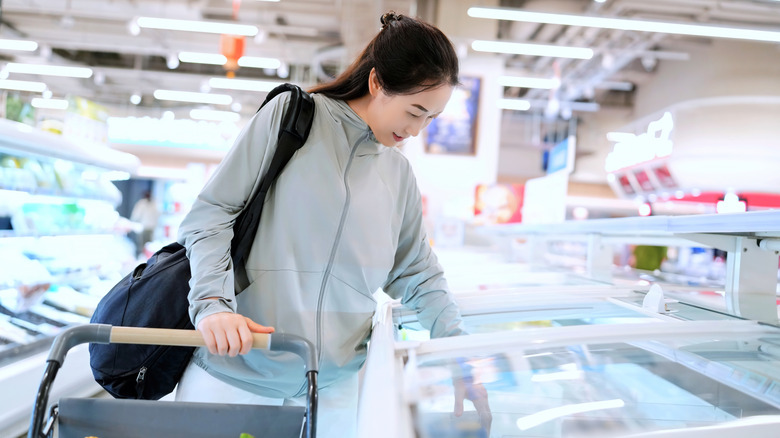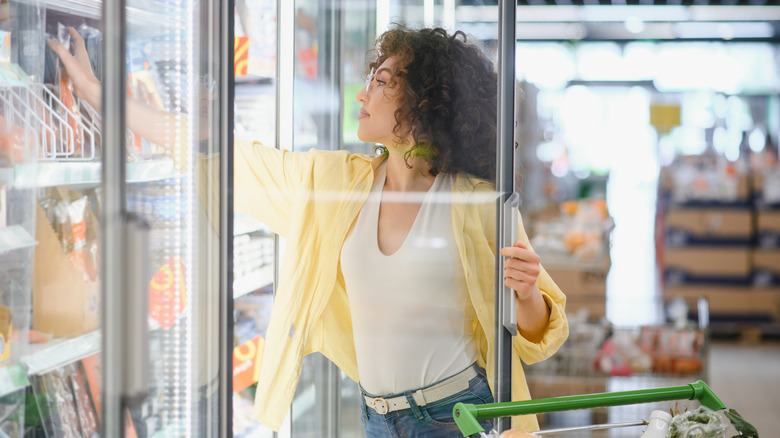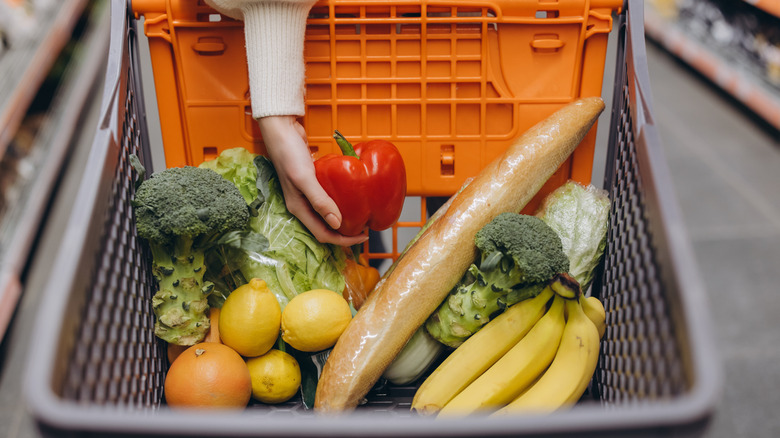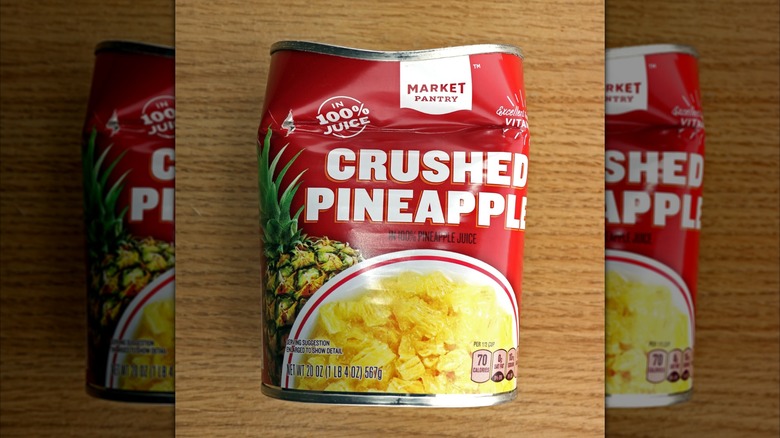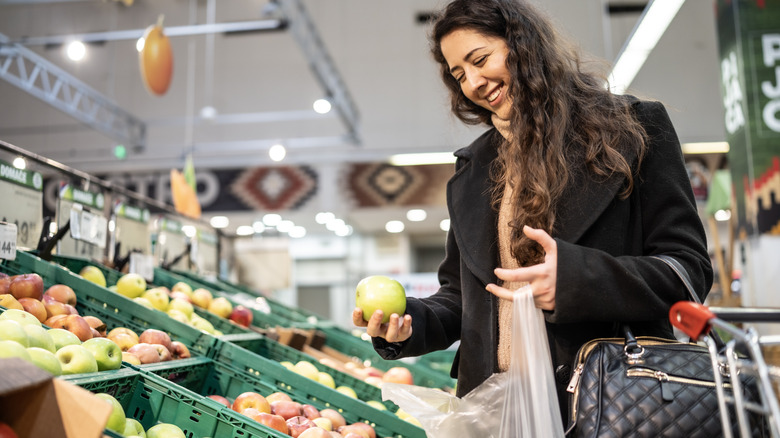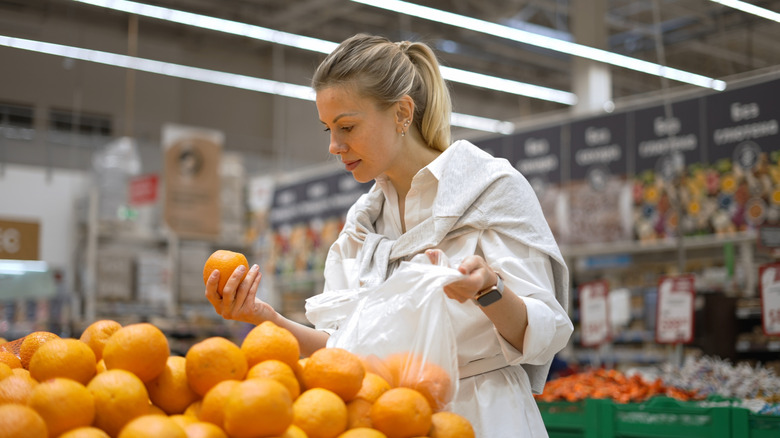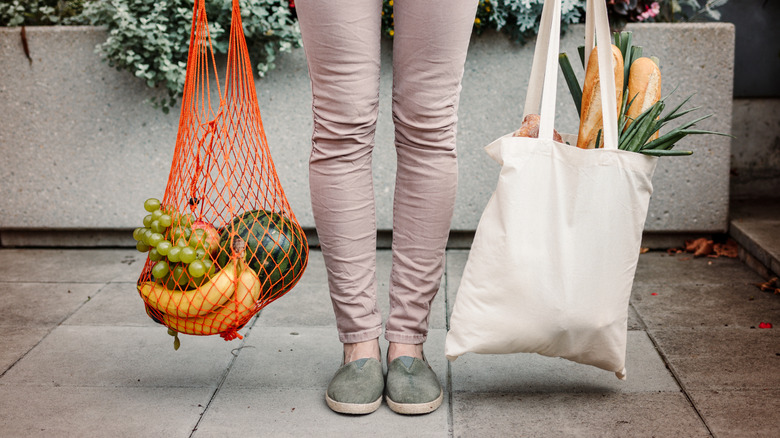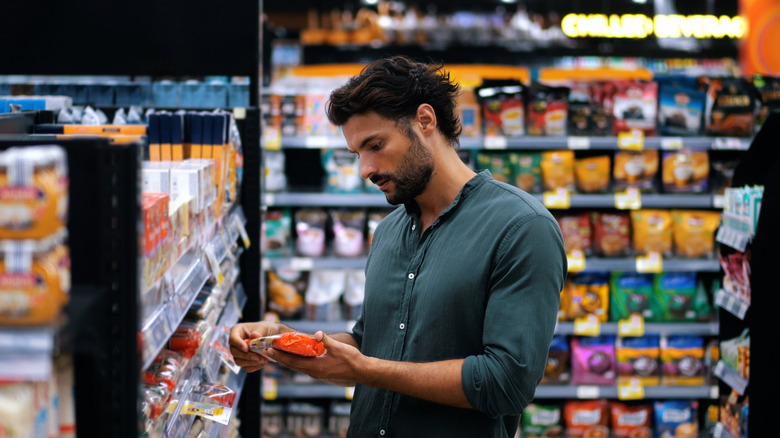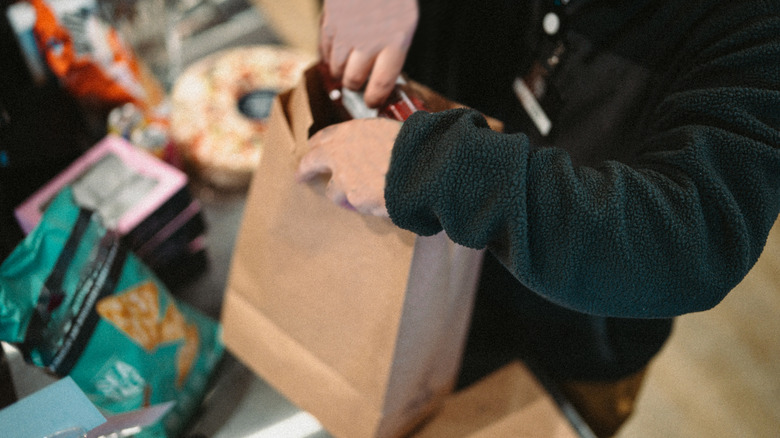14 Food Safety Tips To Keep In Mind When Grocery Shopping
When considering food safety, many only think of these precautions as something to remember while actively cooking. You know the drill: Don't cross-contaminate by slicing raw chicken and using the same cutting board to chop lettuce. Make sure you heat raw foods to a certain temperature. Ensure your refrigerator is clean, that foods like raw meat can't drip onto ready-to-eat foods or produce, and that your fridge and freezer are the right temperatures.
However, food safety begins before you even bring your groceries home. No; we aren't talking about the food safety precautions that manufacturers must observe to avoid potentially deadly recalls. We're talking about smaller, smarter ways to shop that can have a big impact on overall health and food safety. Between manufacturing and arriving at your kitchen, there are certain steps which can be taken at the grocery store to keep your food (and family) safe from illness-causing bacteria.
Avoid stores that don't follow basic food safety guidelines
Before you even step foot into a grocery store: stop. There's a food safety precaution to take as you plan your weekend errands — specifically, choosing the right grocery store.
While we all like to think our regular grocer has customers' best interests in mind, supermarkets are sometimes lax when it comes to following best practices for food safety. Though you might not be able to peek behind the curtain and see what the employees are up to when customers aren't watching, there are tell-tale signs that a store's food safety protocols aren't up to snuff.
If there's anything "dirty" — actual dirt, dust, insects, trash — in the shopping area, that's a big red flag. However, look a bit deeper. Is all of the produce fresh and in top-tier condition? Or is there some rotting fruit left hanging about? Are the coolers and freezers in good working order? If the food in coolers actively sweats, it could mean a cooler is on its last leg and not properly refrigerating your food.
Ensure hot foods are kept out of the danger zone
Many supermarkets offer a selection of hot, prepared foods that shoppers turn to for fast, convenient, and cheap meals. From rotisserie chicken to potato wedges, or macaroni and cheese to mashed potatoes, your main dish and sides are ready for the taking. However, if hot foods have sat at the incorrect temperature, you might be trading your gut health for convenience.
Hot prepared foods should be kept at a temperature of 135 degrees Fahrenheit to prevent bacteria growth. Between 41 degrees and 135 degrees is what's known as "the danger zone" where these germs thrive. Some stores may feature thermometers on their hot cases, which will allow customers to check temperatures for themselves. However, this isn't always the case. When purchasing something packaged, such as buying a rotisserie chicken, take a moment to test the packaging by hand. If the food is kept properly, heat will radiate from the product.
Shop for refrigerated and frozen items last
Many grocery stores place their frozen sections front and center; right after the produce. However, refrigerated items such as eggs, dairy, and cheese can be placed all the way in the back of the store — a well-known tactic to get shoppers walking though the whole store and buying items not originally on their lists. Depending on your shopping habits, you might work your way from produce to dairy, or you might walk to the back of the store and then work your way back to the front. However, this creates a dilemma. Pick the former option, and your frozen food starts thawing by the time you finish shopping. Choose the latter, and your jug of milk sweats at the end of your trip.
To avoid the possibility of refrigerated and frozen foods creeping to an unsafe temperature, pick all your non-perishable food first and foremost. Then grab your frozen foods, and refrigerated items such as deli meat last. While the grocery trip may not last long enough for foods to heat to a dangerous level, remember your groceries also have to last the car ride home and any other stops on the way.
Keep cold foods together in the cart
One way to help cold foods stay cooler for longer is organizing your shopping cart with temperature in mind. While many focus on arranging their carts so soft foods like bread or produce don't wind up smushed, optimal cart arranging can also aid in food safety. Keep frozen and cold foods together on one side of your cart, which will help items such as meat and ice cream keep each other cool.
If you want to get fancy with cart organization, you can purchase organizers to divide your cart into separate sections. These include insulated sections to further keep cold and frozen items chilled. However, there's no need to invest in a full-on gadget or gizmo: A plain ol' insulated cooler bag will do perfectly well. However, bear in mind that even insulated bags aren't foolproof, and may only keep your food safe for several hours.
Keep produce away from ready-to-eat items
When it comes to produce, the first instinct might be to stack fruits and veggies on top of your cart to prevent bruising and damaging. However, pay careful attention to placement. For example, don't place an unwrapped head of romaine lettuce atop rotisserie chicken you just picked up and cover the package's ventilation holes.
While many think of raw meat as the potential big bacteria-spreader in grocery carts, watch out for fresh produce too. Produce can carry bacteria, with certain items considered more high-risk for harboring germs and pathogens than others. Some big offenders include spinach, melons, tomatoes, and lettuce. Bacteria-related produce recalls have affected millions over the years, with nasty customers like salmonella, listeria, and E. coli posing a threat to consumers. So keep in mind: When you plop that head of lettuce onto your ready-to-eat items, you might inadvertently spread bacteria where you don't want it.
Inspect packages and cans for damage
No one wants to waste their heard-earned money by accidentally buying a damaged item that they'll toss on arriving home. As such, thoroughly inspect food packages for damage before placing them in your cart. It's an extra step, but it doesn't take long to verify you're purchasing safe, undamaged food off the shelf.
For example, give boxes and plastic packs a once-over for holes and tears. Test the seal on any jars by pressing against the safety button on top of the lid. If it moves, the seal is broken. For cans: Not all dents are bad, but consider any dent large enough to place your finger in a risk. Any dents along the seams or edges are a hazard, along with cans that are visibly bulging. These cans could be home to botulism-inducing bacteria, which might be one of the scariest foodborne diseases out there.
Always place produce and raw meats in plastic bags
When trying to reduce plastic consumption, you may eschew the bags available all through the grocery store. However, while they might seem wasteful to some, those plastic bags can come in handy when limiting your risk of potential foodborne illness. Raw meat of all kinds (including poultry and seafood) should be bagged and placed in your cart separately from other foods, avoiding contact and potential leakage from the meat's primary packaging. While you're at it, wrap produce in plastic bags to lessen chances of spreading bacteria to your ready-to-eat foods.
Alternatives exist if you balk at the idea of using so much plastic, but be careful which you choose. Mesh produce bags are a popular option, but mesh doesn't provide enough protection to block the transfer of bacteria between foods. Cotton may be a better option for those looking to ditch the plastic.
Look for signs that seafood has gone bad
When buying fresh seafood, don't assume that the offerings on display are the peak of freshness or free from possible pathogens. There are many potential and often obvious signs that seafood isn't fresh, such as ammonia-like smells, swollen packaging, discoloration, slimy or soft textures, open mollusk shells, or even dead lobsters in the lobster tank. Even when buying frozen, there's still a simple seafood red flag to not ignore: ice crystals. If your frozen fish sports large ice crystals, that's a sign the product was thawed and refrozen — meaning your next cut of halibut could already be spoiled.
Cautious consumers should keep an eye out for these red flags to help avoid some of the seafood recalls which have affected millions. From norovirus-riddled oysters and clams to frozen fish contaminated with salmonella, seafood-derived foodborne illness isn't something anyone wants to mess with.
Buy produce loose instead of packaged
While picking up a bag of apples or a plastic-wrapped bell pepper trio is easier than individually selecting produce, take the extra time to buy fruits and veggies loose instead of packaged. Doing so provides more control over the produce you're receiving, and keeps your pantry from winding up with a bag of potatoes that's molding at the bottom, a pouch of spinach gone slimy, or an apple haul with major bruises. Nobody wants to find their shredded lettuce has gone bad when they reach to spread it on a sandwich.
Of course, quality issues in a bag of produce will range in severity; including whether or not they're a health risk. By all means, feel free to eat that bruised apple. However, if produce is slimy, wrinkled, discolored, smelly, or moldy, go ahead and toss it and skip the risk of a spoiled snack.
Wash your reusable grocery bags
If you've invested in reusable grocery bags, don't just toss them back in the trunk for the next trip once you've unloaded your items at home. Take the time to break the cycle and clean your totes, as it's recommended to wash your reusable grocery bags on a regular basis – ideally, after every single use. This ensures you're not cross-contaminating food from shop-to-shop with your bags, no matter what goes inside.
For standard fabric grocery bags, follow the manufacturer's cleaning guidance on the tag. Most can simply be tossed into your washer and dryer along with regular laundry. For insulated bags, wipe the interior down with a disinfecting wipe. Further measures can be taken by using specific grocery bags for different categories of food such as raw meats, prepared foods, produce, and non-perishable items. Either label them as such, or use a color-coded method.
Pay attention to best-by dates
There are few things more frustrating than bringing groceries home, putting them away, and days later preparing a meal ... only to discover an item is already out of date. As you're shopping, pay attention to best-by dates, and keep them in mind as you plan upcoming meals.
Foods might feature four different types of date labels: "best if used by," "sell by," "use by," or "freeze by." If a food says, "freeze by," "best if used by," or "use by," expect that the product will not be of highest quality after the printed date passes (unless freezing it for future use). If a food says "sell by," it's an inventory guideline for the store and doesn't necessarily affect consumers.
None of these popular labels indicate a food should be eaten by a certain day to avoid illness. Instead, these dates are all about quality. While you can eat food after the printed date has passed, the quality will decrease and the food will eventually spoil. The further out the labeled date, the better.
Clean your hands before taking free samples
Who doesn't love free samples? However, take a precaution as you wind your way through the store and snap up those little white cups of complimentary snacks. Before enjoying any samples, make a point to wash your hands. If you can't wash your hands, use hand sanitizer. Though some stores provide sanitizing stations, it never hurts to bring your own. While this won't avoid any germs that have spread as other shoppers linger over the sample tray, it will at least help avoid consuming any of the germs you may've picked up from products or your grocery cart.
Yes: Your shiny silver grocery cart may look benign, but grocery carts are exceptionally germy. After testing nearly 100 grocery carts at random, one Food Protection Trends study found the majority of carts sported both bacteria from human feces and E. coli. Not exactly something you want to eat along with your free sample.
Bag your groceries correctly
You've examined your salmon, checked your cans, and kept those hands sanitized — but you're still not in the clear. Take care bagging your groceries correctly to avoid cross-contamination, keep groceries at the correct temperature, and prevent any damage to your food on the way home.
Just as you'd keep produce and raw meat in separate plastic bags and on their own sides of the cart, make sure they're also in their own grocery bags (yes, even if they're wrapped in plastic). In fact, shoppers who carry reusable bags might add an extra layer of protection by wrapping raw meat in a store bag before placing the package in their own cloth bags.
Finally, keep all cold foods bagged together. Just like placing soft foods at the top of the cart, make sure your eggs are bagged separately too: Nobody wants salmonella-contaminated raw egg leaking onto other foods if the shells jostle and break.
Stay up to date on food recalls
Lastly, one of the best practices for avoiding foodborne illness and safety hazards can happen entirely outside the grocery store: simply keep an eye on the news and watch for food recalls. Food recalls have increased as of late; seemingly making headlines every day. Paying attention to such notices can prevent consumption of a product that might make you sick, especially if the food in question is already in your home.
There are many reasons that foods are recalled, and some of those reasons are more threatening than others. For example, foods recalled due to bacteria contamination or foreign material like wood or glass should not be consumed under any circumstance. However, food that features wrong or incorrect packaging (say it doesn't list a particular allergen) may be safe for some consumers. Still, take these notices seriously as food recalls can be deadly.

